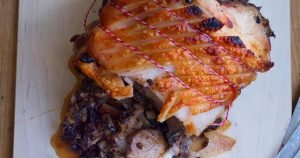
Pork Loin & Black Pudding Wellington with Cabbage & Bacon | Emily Watkins
This recipe, by Emily Watkins, is a fabulous twist on one of our classic dishes. Using hot suet pastry, a slow-cooked aromatic sage & onion puree and served with homemade crackling this is a fantastic dinner party dish.
Recipe by
Source
Serves
6 People
Difficulty
Prep Time
Club Summary
This recipe, by Emily Watkins, is sourced from one of our favourite recipe sites, Great British Chefs. As with most of their recipes, a little more time is required but with instruction from Emily and the use of the finest British ingredients, this is a fabulous twist on one of our classic dishes. Using hot suet pastry, a slow-cooked aromatic sage and onion puree and served with homemade crackling this is a fantastic dinner party dish.
Recipe Credit:
Recipe
Ingredients
For the Pork Loin Wellington
For the Hot Suet Pastry
For the Bacon & Cabbage
- 1 Savoy Cabbage, chiffonade*1
- 100g Bacon Lardons
- 2 Banana Shallots, finely sliced
- 1 knob of Butter
- Salt to season
For the Sage and Onion Purée
- 4 Red Onions, finely sliced
- 1 bunch of Sage
- 100ml Cream
- 20g Butter
- 20ml Vegetable oil
- Salt & Black Pepper to season
For the Sauce
- 1L of Chicken Stock
- 1 Star Anise
- 1 sprig of Sage
- 2 sprigs of Thyme
For the Crackling
Method
- Begin by preparing the sage and onion purée. Heat the butter and vegetable oil in a heavy-based pan over a medium heat. Add the onions and a pinch of salt and sweat for 5-10 minutes. Reduce the heat, place a lid on the pan and cook for 4-5 hours until soft, tender and very sweet.Meanwhile, preheat the oven to 100°C / gas mark 1/4.
- To prepare the crackling, cut the skin into 1cm wide strips, season with flaky sea salt and place in the oven for 4 hours. After 4 hours, raise the oven temperature to 220°C / gas mark 8 and bake for 6-8 minutes until golden and crispy.
- 1 hour before the onions are ready, add the cream and sage bunch to a small saucepan, bring to the boil, then remove from the heat and allow to infuse.
- Once the onions are ready, remove the sage and blend the cream with the onions into a smooth purée. Season to taste and set aside until required.
- To prepare the pork loin, remove all of the sinew and bone from the meat and neatly trim the ends of the loin, reserving any scraps and bones to make a sauce. Vacuum seal*3 the prepared loin and set aside. [Skip to steps 12 / 13 then return]
- Preheat a water bath*3 to 56°C. Cook the pork in the water bath for 1 hour, then refresh in iced water for 10 minutes.
- Remove the pork loin from the bag and cut into neat 170g-180g portions.
- Mix together the black pudding and minced pork, then divide into 6 even portions. Spread 1 portion onto a sheet of cling film to a 1cm thickness. Lay a portion of pork onto 1 end of the mix and roll the black pudding mix around the loin to create an even layer around the meat. Twist the ends of the cling film to seal, then wrap in another sheet of cling film and refrigerate until required. Repeat this process for the remaining 5 portions.
- To prepare the hot suet pastry, place the flour and salt in a bowl. Meanwhile, melt the fat and water together in a pan. Make a well in the flour, then pour the water and fat into the well and mix thoroughly, working to form a paste. Leave to rest for half an hour.
- Wash and blanch the chard leaves for the Wellington in salted boiling water for 1 minute, then remove and refresh in ice cold water. Drain and dry on absorbent kitchen towel before removing any large fibrous veins from the middle of each leaf.
- Divide the pastry into 6 portions and shape each portion into a square. Roll out the pastry to a 3mm thickness, wide enough to easily cover a portion of the pork. Carefully remove the pork loin from the cling film and cover each piece of pastry with the chard leaves. Lay the pork onto the chard, and wrap the pork in the pastry, ensuring that the edges are completely sealed. Set aside on baking paper until required.
- Preheat the oven to 190˚C / gas mark 5
- To prepare the sauce, roast the reserved bones and scraps of meat in the oven until golden. Place in a stockpot, cover with chicken stock and simmer for 2 hours. Pass through a chinois*4 into a clean pan and reduce to a sauce-like consistency. Add the star anise, thyme and sage and set aside to infuse.
- To prepare the cabbage, blanch in salted boiling water, then drain and refresh in cold water.
- Place a saucepan over a medium heat and sauté the lardons until they start to crisp up. No oil is required as the fat will render out the bacon. Add the shallots to the pan and cook until soft.
- Once ready to serve, preheat the deep-fryer to 180°C and cook the Wellingtons for 8 minutes until golden.
- Add the shallots and bacon to the cabbage and warm through, adding a knob of butter
To Serve:
Slice the Wellingtons into 3 even pieces, removing the pastry at the ends for a neater finish if desired. Serve with the crackling, onion purée, sauce and cabbage.
Recipe Notes
- Chiffonade
For the non-chefs - A chopping technique in which herbs or leafy greens (our Savoy Cabbage) are cut into long, thin strips. This is accomplished by stacking leaves, rolling them tightly, then slicing the leaves taking thin strips from the end. - Pig Skin
[/ Pork Fat] You can get this from your local butcher or over the meat counter at your local supermarket. Ask them nicely and you may even get it for free! - Vacuum Pack | Water Bath
We may be in the 21st century, mod cons and all, but this combination of kitchen goodies is generally only in the homes of the most enthusiastic home cook. This method of cooking, also known as Sous Vide, can still be achieved with a large stock pan, kitchen thermometer and a ziplock plastic bag. For this recipe, simply half fill your pan with water, place on the stove top and bring the water to the required 56°. Add the pork to the bag with enough olive oil to coat the meat. Place in the water with the zip open and top secured by the pan lid. Leave for 1 hour checking occasionally that the water temperature is constant. This video by ChefSteps shows you how. - Chinois
Basically, a conical sieve with an extremely fine mesh. It is used to strain custards, purees, soups and sauces to produce a very smooth texture i.e. remove the lumpy bits. If you don't have one, just use the finest mesh sieve you have.
Share the Recipe with Friends....
Facebook
Twitter
Pinterest
Email
Print
Recipe Reviews
What's your Verdict?
{{ reviewsTotal }}{{ options.labels.singularReviewCountLabel }}
{{ reviewsTotal }}{{ options.labels.pluralReviewCountLabel }}
{{ options.labels.newReviewButton }}
{{ userData.canReview.message }}



